Few objects in the Solar System record the remarkable history of our planetary neighbourhood more starkly than the Moon.
Not only does it bear the scars of eons of impacts by asteroids and comets, but its very existence is testament to a cataclysmic collision that’s thought to have forged the Earth we stand on today.
When we gaze at the airless lunar surface, a barren landscape of deep shadows, shining mountain peaks and grey basalt plains, we can also reflect on our own small imprint, quite literally, on the cosmos.
For more advice, read our guide on how to observe the Moon or the best features to observe on the Moon
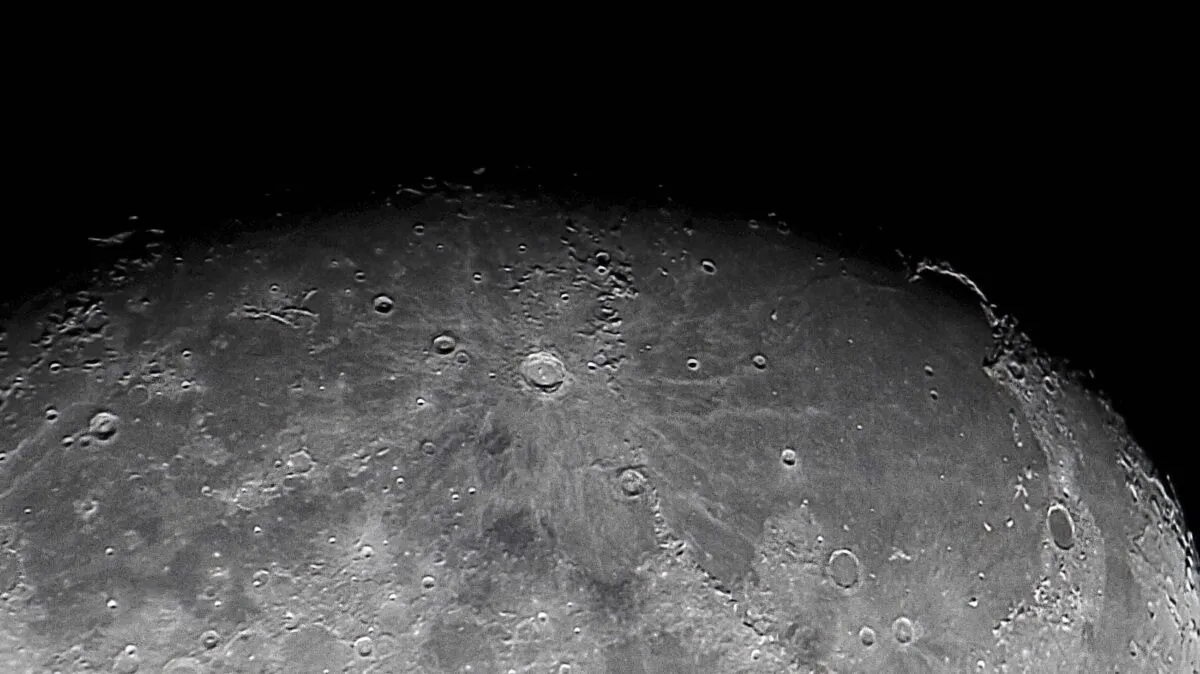
The footprints of the Apollo astronauts remain on the Moon to this day, and likely will do for millennia yet.
Here we'll look at eight areas on the Moon for you to examine with a telescope that tell the story of the past, present and future of our nearest neighbour.
Let’s start by rolling the clock back to the Moon’s early days.
8 features that reveal the history of the Moon
The seas of the near lunar side

See it with: the naked eye or a small telescope
About 4.5 billion years ago, the Moon was formed in a violent impact when an object about the size of Mars smashed into the early Earth.
This cataclysm left a cloud of superheated material circling Earth that, so our current understanding goes, eventually coalesced into the Moon.
After around 500 million years, our companion in space had cooled to form a solid body, rather than a seething ball of molten rock.
But it was around this time that another series of massive impacts are thought to have occurred.
These punched into the lunar globe, leaving enormous scars across its surface, known as basins.
Over time these are believed to have been filled in by immense flows of molten rock from within the Moon, becoming the lunar ‘seas’ we observe on the Moon today.
Known to astronomers as 'lunar maria’, these dark regions create the ‘face’ in the Moon and are visible to even the naked eye.
They are made of dark, basaltic rock and extend in vast, vaguely circular plains across much of the lunar nearside. One of the most interesting to observe with a small telescope is the Mare Nectaris, in the southeast quadrant of the Moon’s disc.
Thought to be just under four billion years old, when the lighting conditions are right you can still see hints of concentric ring shapes thought to be left over from its formation.
Mare Serenitatis wrinkle ridges

See it with: a small telescope
As you cast your eye over some of the lunar seas at the telescope eyepiece, you may notice that these ostensibly smooth basalt plains actually show subtle textures.
Not only are there clear variations in their colour – or rather shade of grey – but they also contain features where the land rises and falls in distinct narrow ridges, winding across the surface.
These are known as ‘wrinkle ridges’ and for a while there was a debate about how exactly they formed.
Were they volcanic in origin or a product of the seas deforming as these landscapes contracted after their formation?
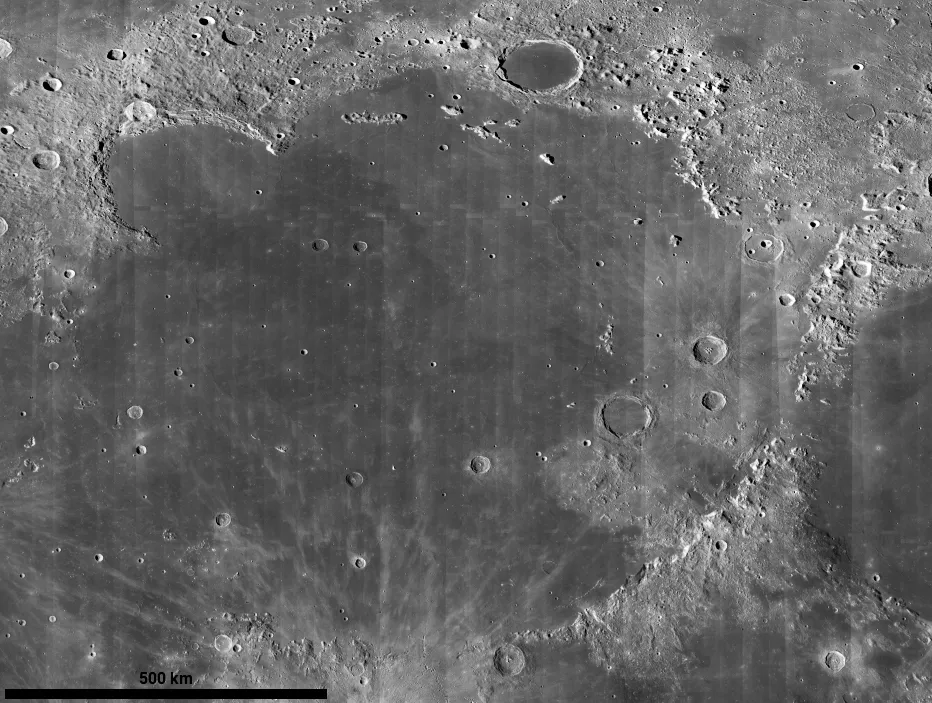
Scientists now think that in most cases it was likely the latter: the ridges emerged when the lunar seas experienced underground movements that wrinkled up the expansive basalt plains above.
With a small telescope of around 4–6 inches in aperture, the best time to look for wrinkle ridges is when they are illuminated obliquely, that is when they are positioned near to the terminator.
We’ve chosen to highlight Mare Serenitatis, pretty much the entirety of which is criss-crossed by wrinkle ridges, and which recent research suggests formed around 3.4 billion years ago.
There are also some other wonderful examples in the northern Mare Imbrium, close to the Bay of Rainbows, so you may want to note when the terminator passes through the region.
Vallis Schröteri

See it with: a small telescope
Lunar volcanism has sculpted and shaped many of the surface features we see through a telescope today. The next two stop-offs in our history of the Moon demonstrate this perfectly.
Within the great expanse of the lunar sea known as Oceanus Procellarum, on the western side of the Moon, lies the striking crater Aristarchus. You can’t miss it.
Even in binoculars its bright walls stand out prominently from the darker plains surrounding it.
Yet, look at it with a telescope and you’ll notice there’s an even more intriguing feature than Aristarchus lying close by.
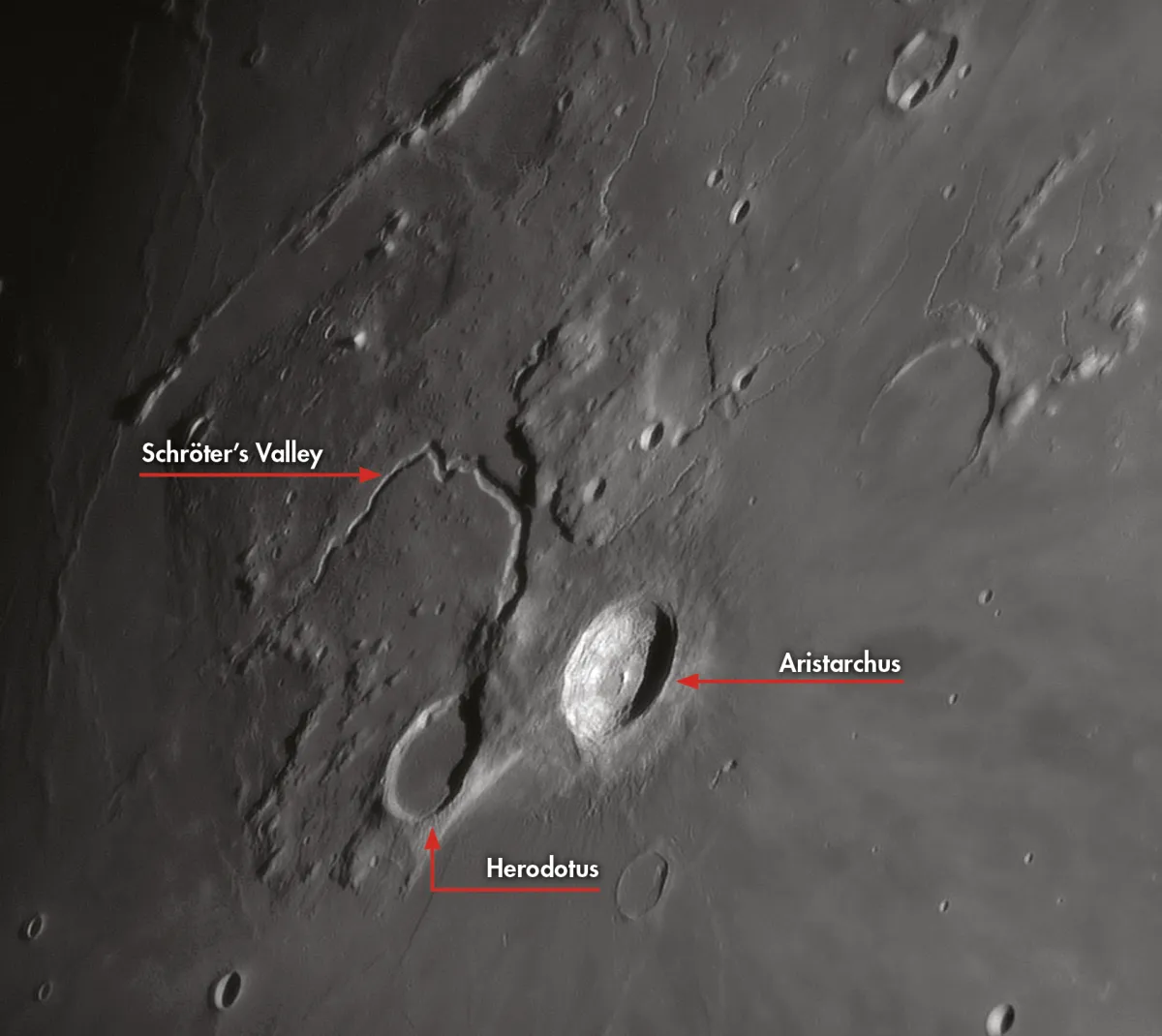
Extending away from the crater to the northwest is a wiggling line, known as the Vallis Schröteri or Schröter’s Valley.
This is what lunar geologists refer to as a ‘sinuous rille’ and it is thought to have been formed about 2.5 billion years ago when an immense eruption of lava carved a long, valley-like path through the landscape.
In total Vallis Schröteri wanders over 160km across the lunar surface and is around 500 metres deep.
Its large extent means that the valley is pretty easy to see in a small scope – though as we’ve seen with other features, the right illumination is key.
The Marius Hills

See it with: a small telescope or a large telescope
Heading south across the Oceanus Procellarum we reach another volcanic landscape thought to have emerged two to three billion years ago, but which may be as young as 800 million years in places.
The surface here, west of the bright crater Kepler, is dominated by huge areas of flat lunar sea and a scattering of moderately-sized craters.
Yet when the terminator sits close to the crater Marius, it is possible to see that there are numerous small peaks in this region rising up from the smooth basalt surroundings of Procellarum.
These raised ‘bumps’ are known as the Marius Hills. Referred to as lunar domes, they are similar to shield volcanoes on Earth, which form when lava oozes onto the surface creating rounded volcanic peaks.
Magma coming up from deep below the surface may then have caused further eruptions that formed the valley-like rilles in this area.
These can also be photographed with modest imaging equipment on large telescopes. To see the Marius Hills well visually, though, you’ll need a telescope of 150–200mm and a night of good seeing.
Copernicus crater
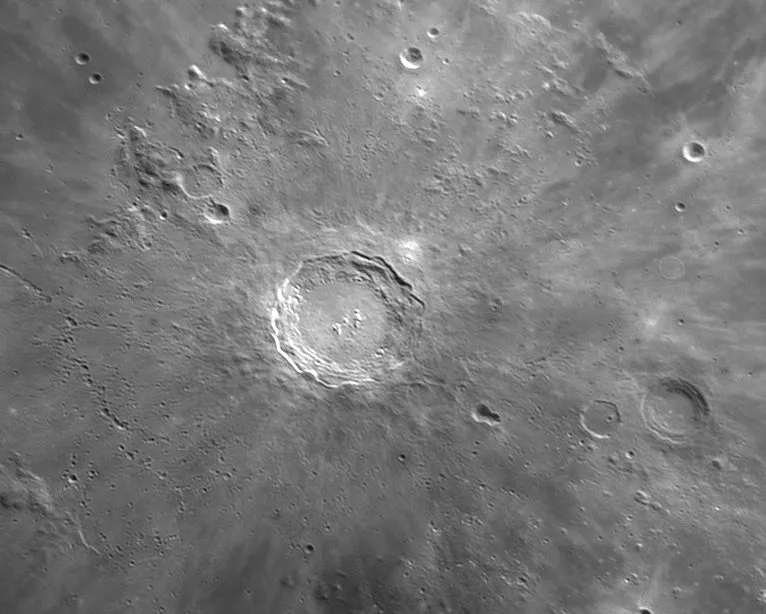
See it with: the naked eye, binoculars or a small telescope
There is perhaps no better reminder of the Moon’s dramatic history than the myriad craters that pepper its globe – from the centimetre-sized ones visible in Apollo surface images, all the way up to those large enough to see from Earth with the naked eye.
The rate of asteroid and comet impacts has dropped off over time, but even today small meteoroids still slam into the surface.
The craters of the Moon have been central to piecing together its history.
When linked to the samples returned home by the US Apollo missions, the density of craters on any given surface and how they overlap can be used as proxies for the age of that landscape.
Detective work like this leads planetary scientists to believe that the crater Copernicus is 800 million years old. Its formation marks the start of the ‘Copernican’ era that extends to the present.
Copernicus is one of the Moon’s most visually stunning craters.
As well as having rippling terraced walls that change appearance over the lunar day, it is surrounded by an impressive ray system.
These were made when lunar ray ejecta was thrown over 600km away during the violent impact that created Copernicus.
The Apollo 11 landing site
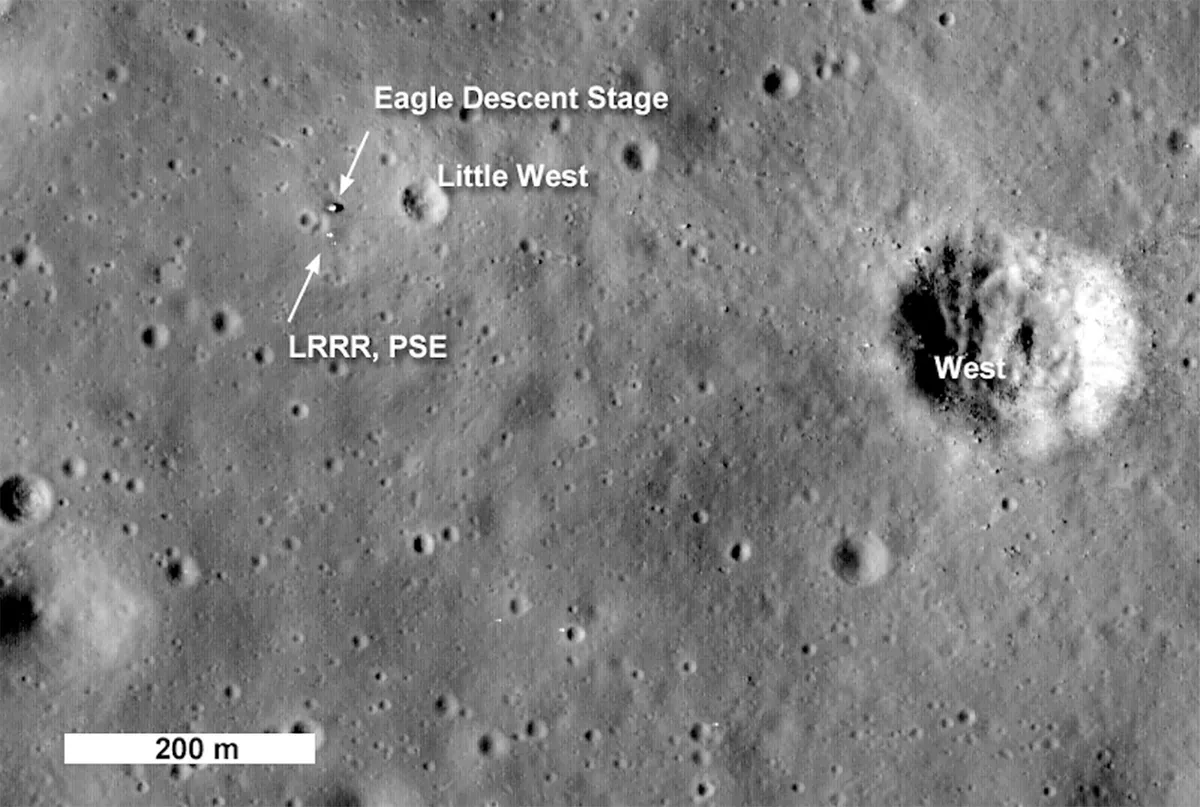
See it with: a large telescope
Our next stop brings us to where the timeline of our own species and that of our nearest neighbour intersect.
More than 50 years ago, humanity made its first steps onto another world during the Apollo 11 mission.
The landing site where US astronauts Neil Armstrong and Edwin ‘Buzz’ Aldrin completed that historic exploration lies in the southern half of the Mare Tranquillitatis, the Sea of Tranquility.
While it is not possible to see any of the mission hardware that the crew left there with a telescope from Earth, NASA’s Lunar Reconnaissance Orbiter in orbit around the Moon has been able to photograph the lunar module descent stage and trails left by the astronauts.
It can still be fun to track down the landing area at the eyepiece, though.
First locate the pair of craters Ritter and Sabine on the edge of the Mare Tranquillitatis.
Then track your eye towards the promontory that pokes out into the sea close to the crater Moltke.
About half way along this line is the area where Apollo 11 landed.
For more help with this, read our guide on how to observe the Apollo 11 landing site.
Chang'e 5 landing site

See it with: a small telescope
We may not have walked on the Moon for decades, but uncrewed missions have continued to explore it in our place.
Today, the US Lunar Reconnaissance Orbiter circles the Moon capturing exquisitely detailed images, while recent Chinese missions have heralded a new era of robotic lunar surface exploration.
Among these is the Chang’e 3 mission, whose lander and rover touched down in 2013, and the Chang’e 4 mission that made the first landing on the lunar far side, in Von Kármán crater, in 2019.
It was able to return high-resolution images of the area and deploy a rover to explore features up-close. Another success for the Chinese came in 2020, with the landing of Chang’e 5.
It was deployed to a landing site in the northern Oceanus Procellarum or Ocean of Storms, where it gathered almost 2kg of samples that were returned to Earth by a spacecraft waiting in lunar orbit.
Chang’e 4’s landing site is hidden from view on the far side of the Moon, but with a small telescope it is possible to see the wide region that Chang’e 5 studied.
The landing site is a little way northeast of the fascinating volcanic feature Mons Rümker.
The lunar south pole
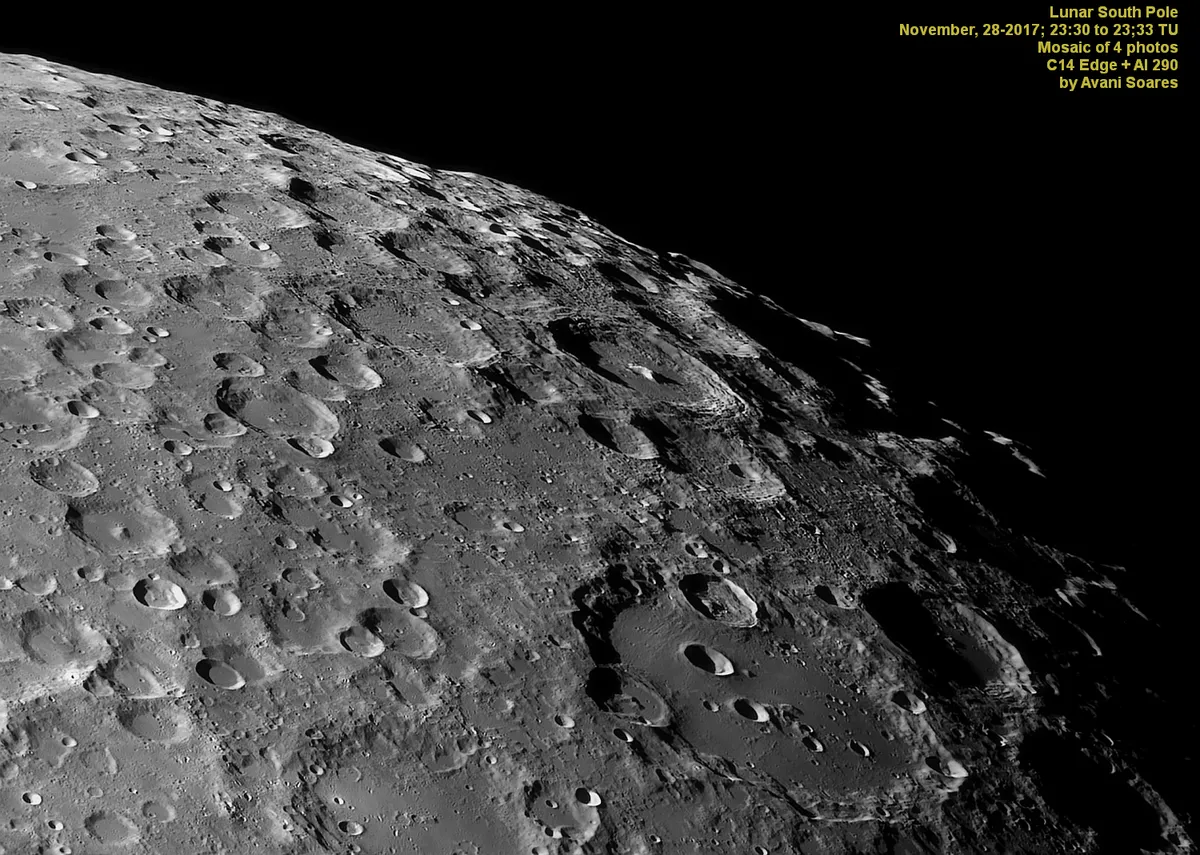
See it with: a large telescope
We finish our observing tour with a look to the future. While the Moon will be largely unchanged for eons, it may once again become a destination that humans visit and explore.
Certainly that’s the hope of many space agencies and commercial entities around the world.
But such plans have been mooted for decades and deadlines all too often slip further beyond the horizon.
Will the current push to return there, perhaps for longer periods, be the one that finally happens?
If it is, there is one place that will be high on the list of possible landing sites: the lunar south pole region, near Shackleton crater.
In fact, NASA has already picked out several potential landing spots in the region for its planned human landing mission, Artemis III.
There, permanently shadowed craters offer the promise of water-ice, which could be used for making rocket fuel, while sunlit peaks and crater rims provide sites for bases with solar panels.
For us amateur astronomers, the south pole region is also a fascinating area to take in at the eyepiece, with huge craters, mountains and undulating terrain creating a rich and captivating view in medium- to large-aperture telescopes using high magnification.
Cast your eye over it when conditions are favourable, because it could be a place where the next chapter in the Moon’s history is about to be written.
This guide originally appeared in the November 2022 issue of BBC Sky at Night Magazine.
